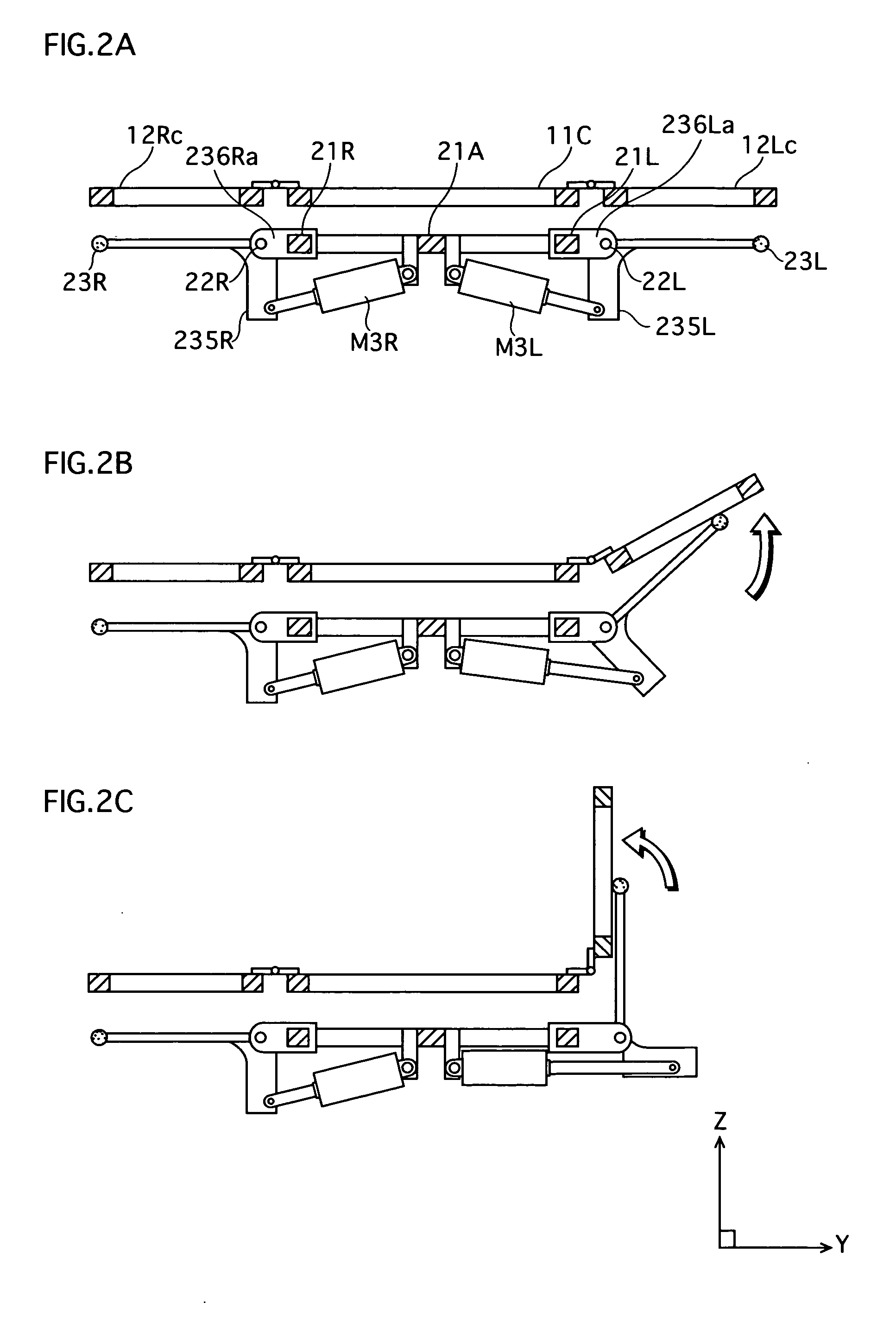Movable bed
- Summary
- Abstract
- Description
- Claims
- Application Information
AI Technical Summary
Benefits of technology
Problems solved by technology
Method used
Image
Examples
embodiment 1
1. Embodiment 1
1.1 Structure of Turning Bed
[0046]FIG. 1 is a perspective view showing a structure of a turning bed 1 relating to an embodiment 1 of the present invention.
[0047] Turning bed 1 is constituted such that a bed frame 10 is disposed on an adjustable stage 20 sitting on a fixed stage 30.
[0048] Bed frame 10 includes coupled platforms 11a to 11d, which are formed by dividing a surface section (i.e. upper surface of the bed) into four articular sections corresponding to the back, hip, upper leg, and lower leg regions of the care recipient's body when lying on the bed, and coupling these sections together so as to be fully adjustable. Of these four coupled platforms 11a-11d, lower-back board 11b is fixed directly to adjustable stage 20 by being welded, for example, thus preventing bed frame 10 from separating from adjustable stage 20. Side members 12Ra-12Rd and 12La-12Ld for supporting the care recipient's body from the side are coupled to platforms 11a-11d on the right and...
embodiment 2
2. Embodiment 2
[0114]FIG. 25A is a perspective view showing a structure of a turning bed in an embodiment 2.
[0115] While the bed structure in embodiment 1 is driven using parallelogram mechanisms, in embodiment 2, direct-acting actuators are disposed vertically, and side members on the left or right are elevated vertically using elevation mechanisms, thus enabling platforms positioned above an adjustable stage to be titled.
[0116] With the turning bed of embodiment 2, a pair of columnar direct-acting actuators is disposed within a rectangular fixed stage, and a bed frame supported by an adjustable stage is positioned on top of the actuators. The platforms, as in embodiment 1, are constructed as coupled platforms that are coupled together by a plurality of joints corresponding to the care recipient's upper body, hip, upper leg, and lower leg regions. Of these, the section corresponding to the upper-leg board is secured to the adjustable frame, which has a frame construction equivale...
embodiment 3
3. Embodiment 3
[0119]FIGS. 26A to 26F show a structure of a turning bed in an embodiment 3.
[0120] The turning bed in embodiment 3, which can be used with general-purpose beds, is constituted by laying an air mattress formed from a plurality of airbags on a general-purpose bed. A characteristic of this turning bed is the use of an air pump (not depicted) to supply / discharge air independently for each airbag via an air hose. The air hose has a valve that is controlled to open / close by a control unit (not depicted), thus controlling the inflation / deflation of respective airbags. The airbags are, as one example, partitioned into upper body (double layer), lower back (double layer), upper leg, lower leg, and both sides of the bed so as to correspond to the joints of the care recipient's body.
[0121] A turning bed having the above structure is normally used with a mattress or the like placed over the air mattress. When turning the care recipient from a supine to a lateral position, the u...
PUM
 Login to View More
Login to View More Abstract
Description
Claims
Application Information
 Login to View More
Login to View More - R&D
- Intellectual Property
- Life Sciences
- Materials
- Tech Scout
- Unparalleled Data Quality
- Higher Quality Content
- 60% Fewer Hallucinations
Browse by: Latest US Patents, China's latest patents, Technical Efficacy Thesaurus, Application Domain, Technology Topic, Popular Technical Reports.
© 2025 PatSnap. All rights reserved.Legal|Privacy policy|Modern Slavery Act Transparency Statement|Sitemap|About US| Contact US: help@patsnap.com



